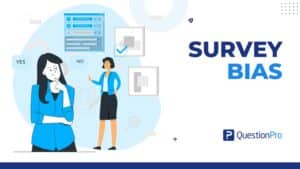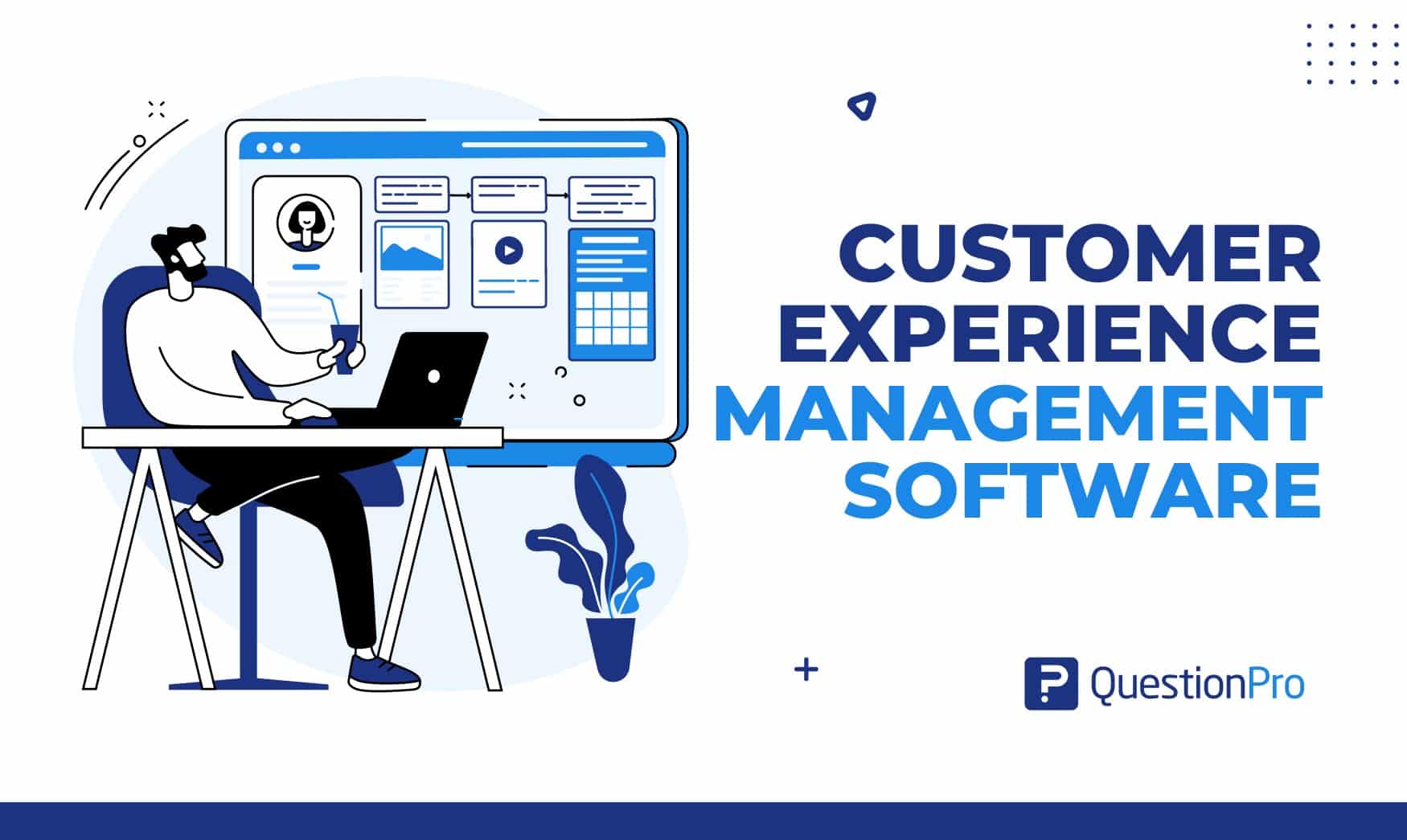
Customer experience management software (CEM software) is a powerful tool to help businesses understand, analyze, and enhance customer experiences across various touchpoints. In today’s competitive landscape, providing exceptional customer experiences is paramount for companies looking to differentiate themselves and foster loyalty.
CEM software typically aggregates customer experience data from multiple sources, such as customer feedback, surveys, social media interactions, and transaction histories. By leveraging advanced analytics and artificial intelligence, this customer experience software enables businesses to achieve actionable insights into customer behavior, preferences, and sentiment.
We’ve compiled a list of the top 21 customer experience management software platforms. These platforms have been selected based on functionality, user-friendliness, scalability, innovation, and customer satisfaction. Whether you’re a small startup or a multinational corporation, a solution on this list will help you elevate your customer experience strategies to new heights.
What is Customer Experience Management?
Customer Experience Management is designing, implementing, and monitoring strategies and processes to improve and optimize every customer interaction with a business or brand loyalty. It encompasses all customer touchpoints and channels customers engage with a company, including online platforms, physical stores, customer service interactions, social media, and more.
CEM is about understanding and meeting customers’ needs, preferences, and expectations to create positive, memorable experiences that foster loyalty, satisfaction, and advocacy. It involves collecting and analyzing customer feedback, identifying pain points and opportunities for improvement, and implementing changes to enhance the overall customer journey.
Key aspects of customer experience management include:
- Customer Understanding: Gaining insights into customer behaviors, preferences, and needs through customer data analysis, market research, and feedback collection.
- Customer Engagement: Creating meaningful and personalized customer interactions across all touchpoints and channels fosters engagement and loyalty.
- Customer Feedback Management: Collecting, analyzing, and acting upon customer feedback to identify improvement areas and measure satisfaction levels.
- Omnichannel Experience: Ensuring consistency and seamlessness in customer experience automation across all channels and platforms, allowing customers to transition effortlessly between different touchpoints.
- Continuous Improvement: Implementing processes and strategies to continuously monitor and enhance the customer experience based on feedback and performance metrics.
By prioritizing customer experience management, businesses can differentiate in a competitive market, build stronger customer relationships, and drive long-term success and profitability.
What is Customer Experience Management Software?
Customer experience management software refers to technology solutions used to help businesses manage and improve the interactions and experiences they provide to their customers across various touchpoints and channels. CEM software encompasses a range of functionalities aimed at understanding, analyzing, and optimizing every aspect of the customer journey to enhance satisfaction, loyalty, and advocacy.
CEM software empowers organizations to monitor customer journeys, identify pain points, and precisely locate improvement areas. They can also personalize interactions, tailor marketing strategies, and optimize products and services to better fulfill customer needs and expectations.
Customer experience management software helps businesses build strong customer relationships, enhance satisfaction, and foster loyalty in today’s competitive market. Companies can stand out and thrive in their industries by effectively understanding and meeting customer needs.
Key Features of CEM Software for Customer Satisfaction
Key features of Customer Experience Management (CEM) software that directly contribute to customer satisfaction include:
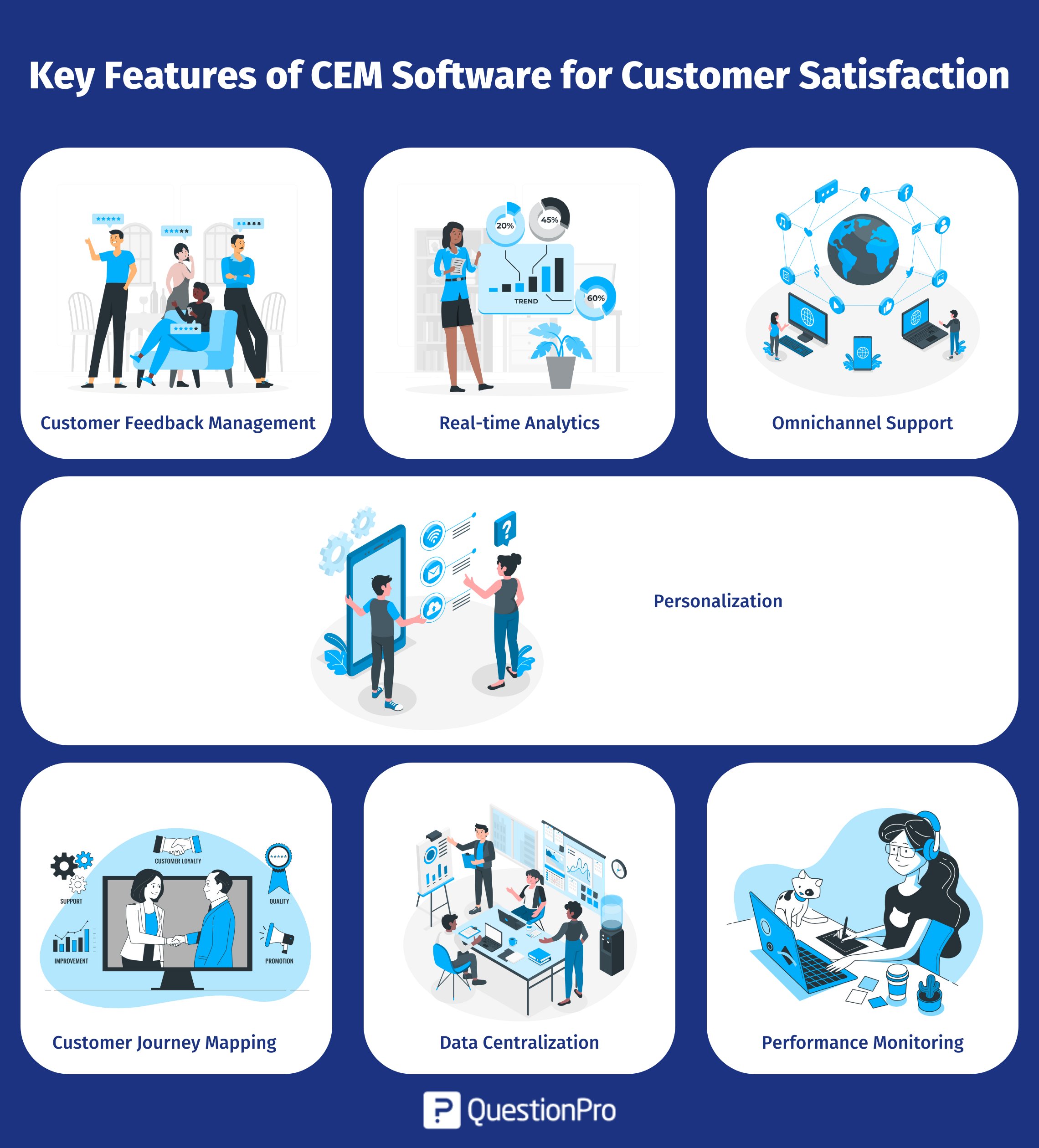
1. Customer Feedback Management
This feature enables businesses to collect and analyze customer feedback through different channels, such as surveys, reviews, and social media. It helps organizations gain valuable insights into customer perceptions, preferences, and pain points, which can be used to drive product, service, and process improvements.
2. Real-time Analytics
Customer experience management tools provide real-time analytics capabilities that enable businesses to track customer interactions and behaviors as they happen. It allows organizations to promptly identify emerging issues, trends, or opportunities and take immediate action to address them, thereby enhancing customer satisfaction and loyalty.
3. Omnichannel Support
Omnichannel support enables businesses to provide:
- Consistent customer service across various channels.
- Seamless interactions across phone, email, chat, social media, and in-person.
Customers can contact for assistance through their preferred communication method, enhancing satisfaction and convenience.
4. Personalization
Personalization features in CEM software allow businesses to deliver customized experiences to individual customers based on their preferences, purchase history, and behavior. Organizations can deepen customer engagement, increase loyalty, and drive satisfaction by providing relevant and targeted interactions.
5. Customer Journey Mapping
Customer journey mapping functionality helps businesses visualize and understand the end-to-end customer journey, from initial awareness to post-purchase support. By identifying key touchpoints, pain points, and moments of truth along the journey, organizations can pinpoint areas for improvement and enhance customer experience.
6. Data Centralization
This feature centralizes customer data from various sources into a single, unified database, including:
- CRM systems.
- Marketing platforms.
- Customer support tools.
Benefits of centralizing customer data:
- A comprehensive view of customer interactions and preferences.
- More personalized and relevant experiences.
- Enhanced customer satisfaction and loyalty.
7. Performance Monitoring
CEM software empowers businesses to monitor vital indicators of customer satisfaction, including metrics like Net Promoter Score (NPS), Customer Satisfaction Score (CSAT), and Customer Effort Score (CES). By keeping a close eye on these metrics, organizations can assess the impact of their customer experience efforts and pinpoint areas for improvement.
By leveraging these features, businesses can effectively address customer needs, deliver personalized experiences, and ultimately enhance satisfaction and loyalty.
Importance of Customer Experience Management Software
Customer Experience Management (CEM) software plays a crucial role in today’s business landscape due to several key reasons:
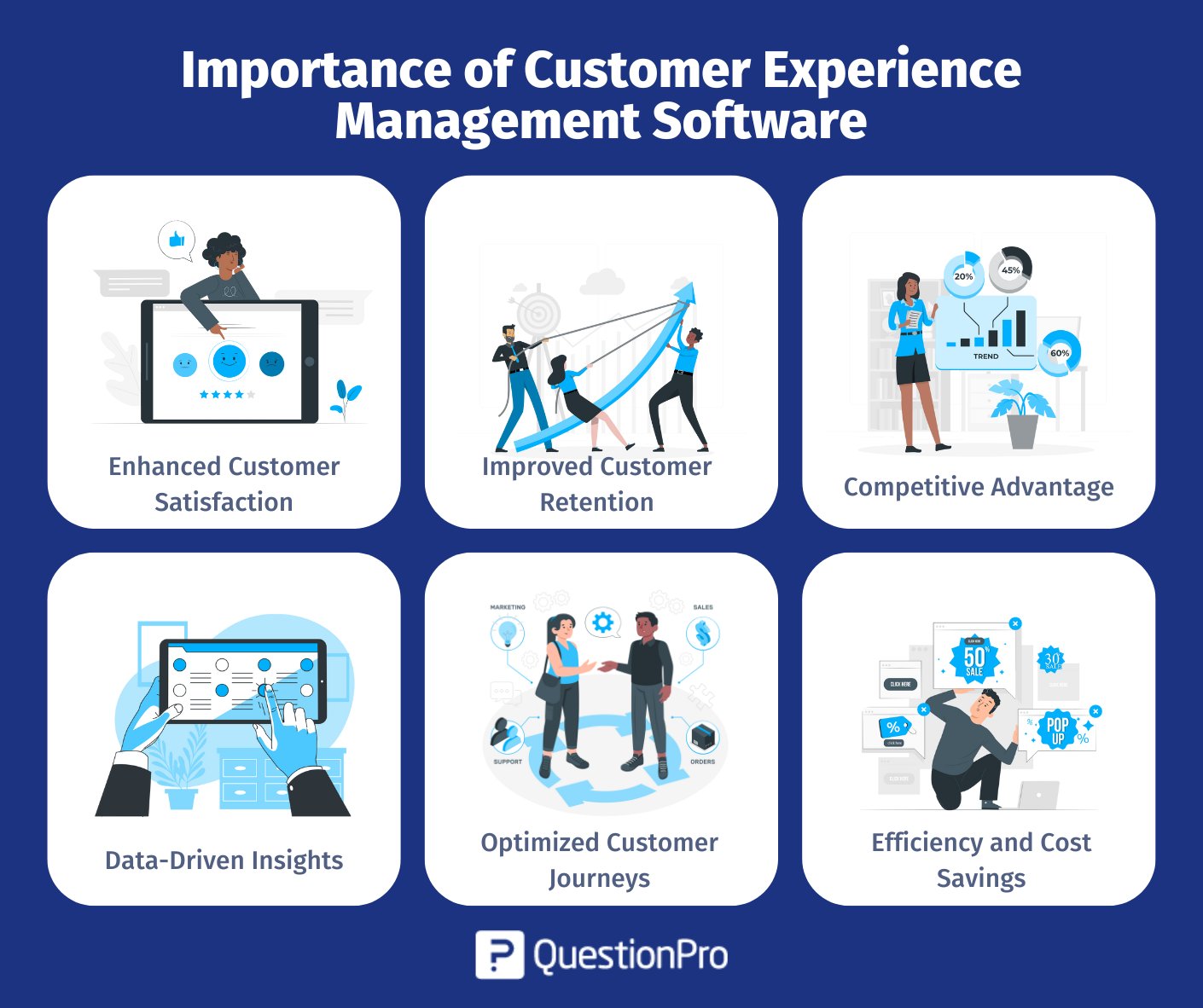
1. Enhanced Customer Satisfaction
By understanding and addressing customer information effectively, CEM software enables businesses to deliver exceptional experiences, leading to higher satisfaction and loyalty among existing customers.
2. Improved Customer Retention
Satisfied customers are likely to:
- Remain loyal to a brand.
- Make repeat purchases.
CEM (Customer Experience Management) software helps businesses:
- Identify and rectify issues promptly.
- Reduce customer churn rates.
- Increase the customer lifetime value.
3. Competitive Advantage
In a competitive market, superior customer experience sets businesses apart. CEM software allows organizations to differentiate by providing personalized, consistent, seamless experiences that exceed customer expectations.
4. Data-Driven Insights
CEM software collects and analyzes vast customer data, providing valuable insights into preferences, behaviors, and trends. These insights enable businesses to make informed decisions and effectively tailor their strategies to meet evolving customer emotions and needs.
5. Optimized Customer Journeys
CEM software helps to:
- Enable businesses to map and optimize the entire customer journey.
- Cover the journey from initial communication to post-purchase support.
- Can streamline processes using CEM software.
- Help eliminate friction points in the customer journey.
By using CEM software, businesses can create seamless and memorable customer experiences.
6. Efficiency and Cost Savings
Automation features in CEM software streamline repetitive tasks and workflows, reducing manual effort and operational costs. This efficiency allows businesses to allocate resources more effectively and focus on delivering value-added services to customers.
Customer experience management software is important for businesses looking to thrive in today’s customer-centric market by prioritizing and optimizing every aspect of the customer journeys.
21 Best Customer Experience Management Software
In today’s customer-driven market, businesses recognize the critical importance of delivering exceptional customer experiences. Let’s explore some of the top CEM software solutions and how they improve customer satisfaction and loyalty.
1. QuestionPro
QuestionPro CX offers a comprehensive customer experience management platform for collecting and analyzing customer feedback through customer satisfaction survey, polls, and forms. Its real-time analytics and reporting tools provide valuable insights into customer sentiments, preferences, and behavior, empowering businesses to lead data-driven decisions to enhance the overall customer experience.
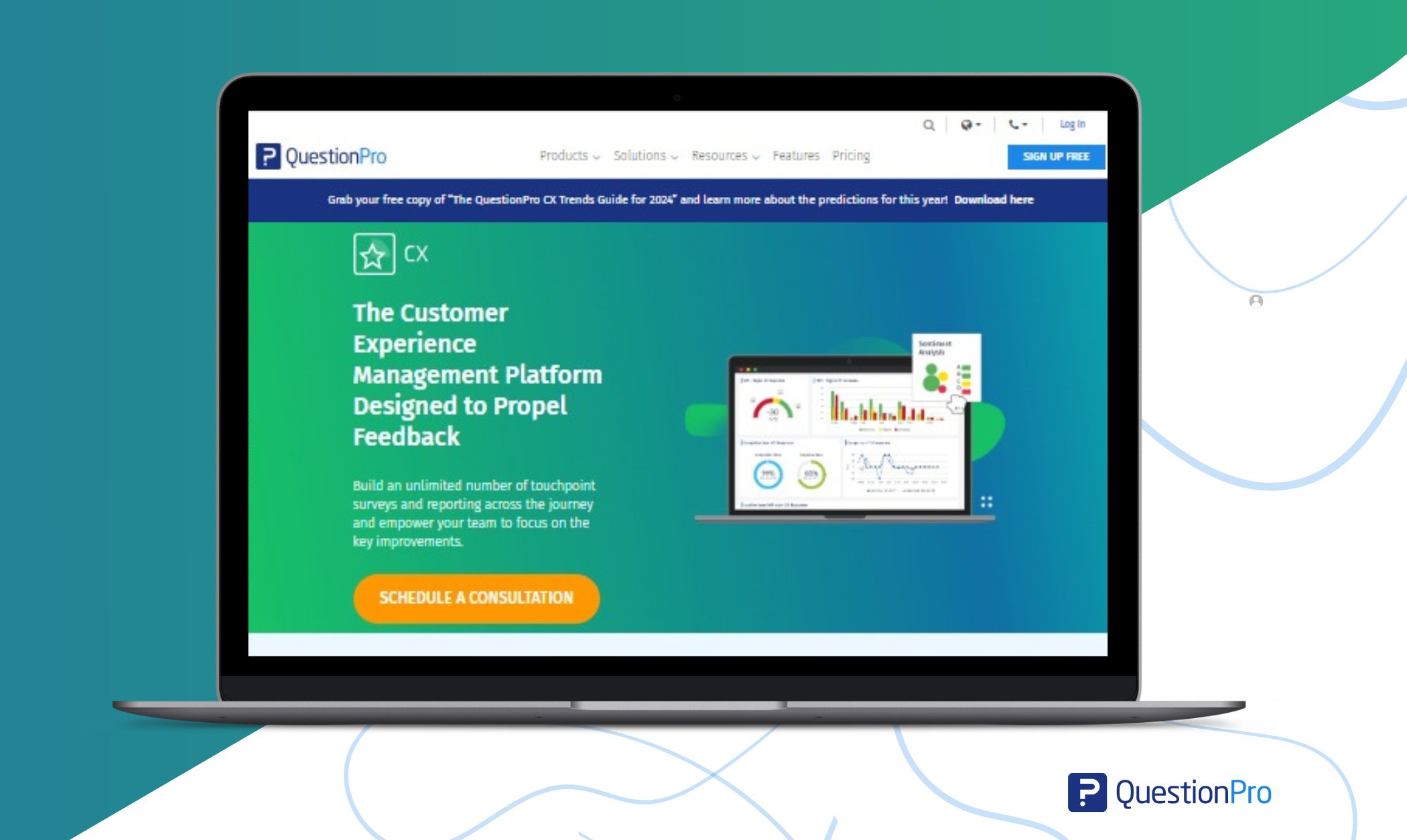
Features:
- Comprehensive feedback management tools
- Real-time analytics for immediate insights
- Multichannel support for gathering feedback
- Personalization options for tailored surveys
- Predictive customer analytics for anticipating customer needs
- Integration capabilities with other business systems
Limitation:
- Advanced features require more effort and resources to be effectively used
- May experience occasional bugs or glitches in the platform
Pricing:
Most popular plans start at $99 per month, with pricing tiers available for businesses of all sizes. Custom pricing options are available for enterprises with specific needs.
2. Jotform
It is an online form builder that helps businesses create and deploy surveys, registration, and feedback forms. Its customization, integration, and analytics features help organizations gather valuable feedback and insights to improve the customer experience.
Features:
- Online form builder for creating surveys and feedback forms
- Customizable form templates for various use cases
- Real-time form analytics and reporting
- Integration with CRM and other business systems
- Mobile-friendly forms for capturing feedback on any device
- Secure data storage and GDPR compliance features
Limitations:
- Limited integration capabilities compared to more robust survey tools
- Some users report occasional glitches or technical issues with the platform
- Advanced features may be lacking in lower-tier pricing plans
Pricing:
The bronze plan starts at $34 per month and is billed annually. The silver plan starts at $39 per month and is billed annually. The gold plan starts at $99 per month, is billed annually, and includes advanced form analytics and automation features.
3. Qualtrics
Qualtrics is an industry-leading experience management platform that enables businesses to collect, analyze, and act on customer feedback across various touchpoints. With advanced survey tools, robust data visualization capabilities, and predictive analytics, Qualtrics helps organizations gain deep insights into customer perceptions and behaviors, driving meaningful improvements in the customer experience.
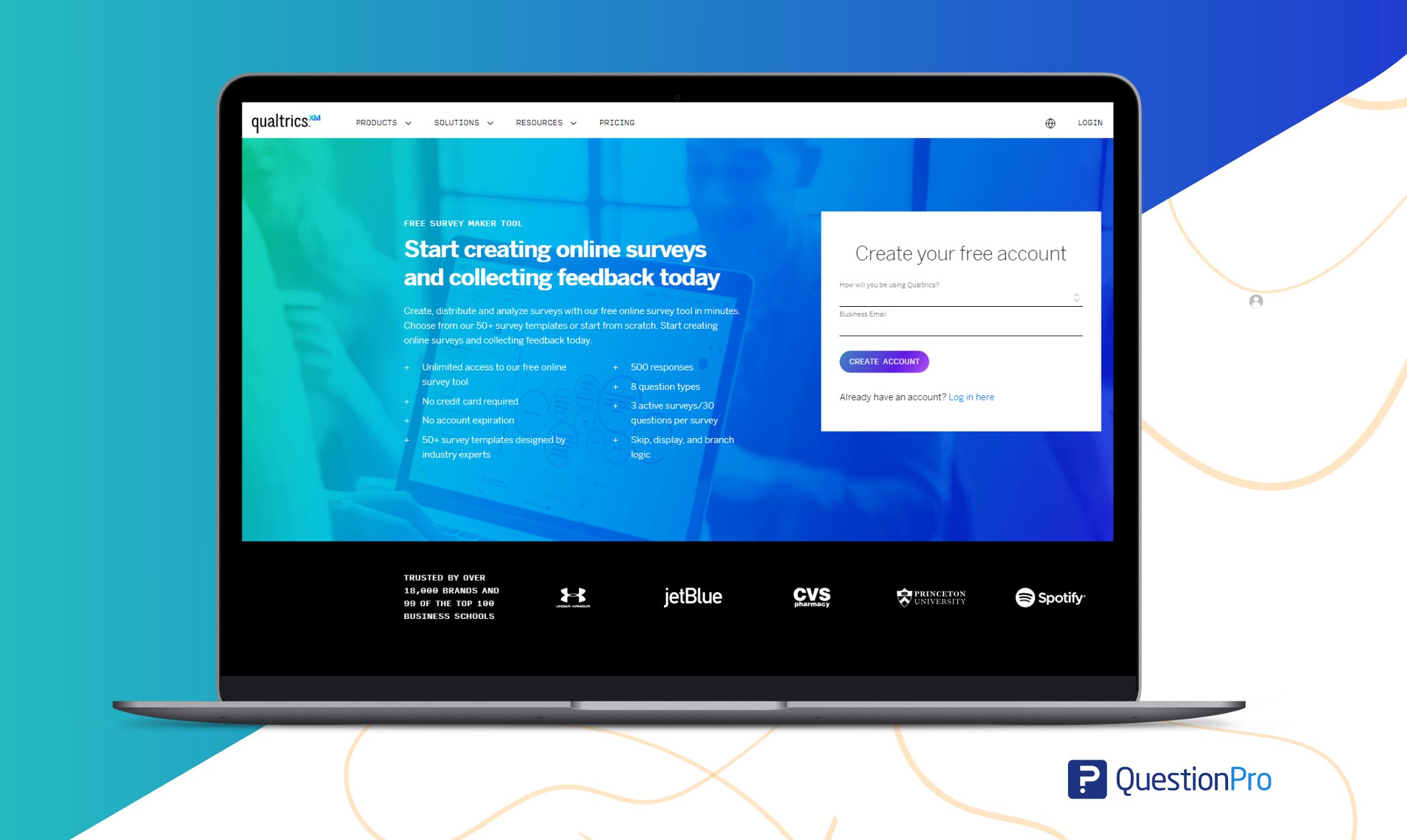
Features:
- Advanced survey creation and customization options
- Powerful analytics and reporting tools
- Omnichannel feedback collection capabilities
- Personalized customer experience solutions
- AI-driven predictive analytics for insights
- Integration with CRM and other business platforms
Limitations:
- High cost of entry, especially for smaller businesses
- The complexity of the platform may require extensive training
- Some advanced features may not be utilized fully by all users
- Limited customer support options for lower-tier plans
Pricing:
Pricing varies depending on the edition and features required, with plans typically starting from around $1,500 to $2,500 per year. Provides custom pricing based on the needs and scale of the organization.
4. Podium
Podium is a customer interaction platform that helps businesses manage online reviews, messages, and feedback. Its tools for review management, messaging, and customer insights enable organizations to engage with customers effectively and enhance their online reputation and customer experience.
Features:
- Review customer data management tools for monitoring and responding to online reviews
- Messaging platform for communicating with customers
- Feedback collection features for gathering customer insights
- Integration with popular review platforms
- Analytics dashboard for tracking online reputation metrics
- Mobile-friendly tools for managing customer communication on the go
Limitations:
- Pricing plans may not be suitable for smaller businesses or startups
- Some users report challenges in integrating Podium with other systems
- Limited customization options for review request templates and messaging
Pricing:
Pricing is available upon request, with tailored plans based on business size and needs.
5. HubSpot
HubSpot’s customer experience management software helps businesses attract, engage, and delight customers throughout their journey. With its all-in-one CRM, marketing automation, customer support, and analytics tools, HubSpot enables organizations to deliver personalized experiences across multiple channels, driving customer loyalty and satisfaction.
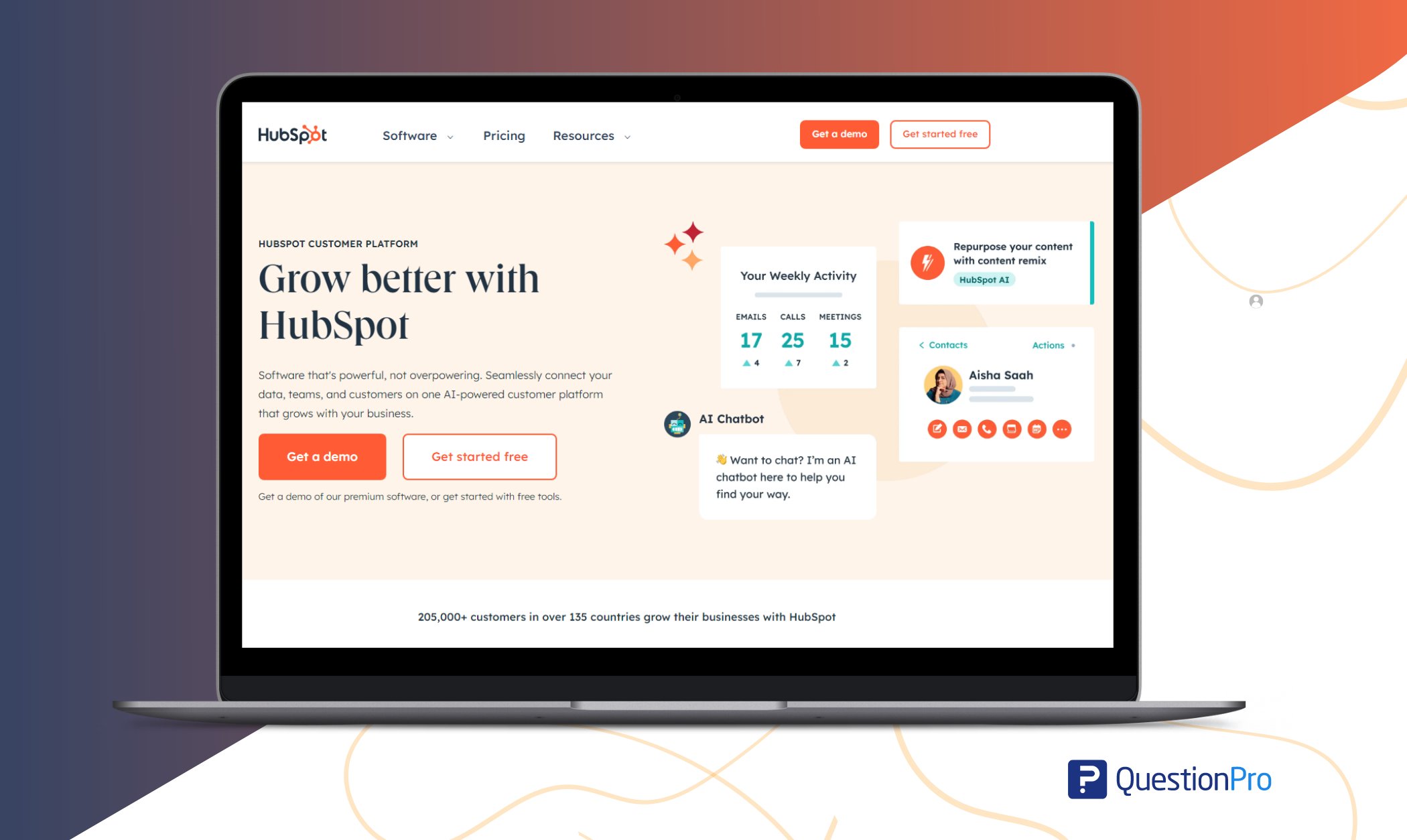
Features:
- Integrated CRM for managing customer interactions
- Marketing automation tools for personalized messaging
- Customer support features for efficient issue resolution
- Analytics dashboard for tracking customer engagement
- Omnichannel marketing capabilities
- Workflow automation for seamless customer experiences
Limitations:
- Feature sets may be overwhelming for smaller businesses
- Integration with other platforms can sometimes be challenging
- Certain advanced features may require additional costs
- Pricing plans may not be affordable for startups or small businesses
Pricing:
The starter plan starts at around $50 monthly, with additional features available in higher-tier plans starting from $400 monthly.
6. Birdeye
Birdeye is a comprehensive reputation management platform that helps businesses manage online reviews, gather customer feedback, and improve their online presence. Its robust features include review monitoring, sentiment analysis, insights, and competitive benchmarking, empowering businesses to enhance their reputation and customer experience.
Features:
- Online reputation management tools
- Review monitoring and response features
- Sentiment analysis for understanding customer feedback
- Competitive benchmarking insights
- Customer sentiment tracking over time
- Integration with popular review platforms
Limitations:
- Limited customization options for review requests and surveys
- Some users report occasional delays in review monitoring and notifications
- Pricing plans may be on the higher side for businesses with smaller budgets
Pricing:
Pricing is available upon request, with customized plans based on business requirements.
7. Survicate
Survicate is a versatile customer feedback platform that enables businesses to collect feedback through surveys, NPS, and website feedback widgets. Its customizable survey templates, advanced targeting options, and actionable analytics help organizations gather valuable insights and drive informed decisions to enhance the customer experience.
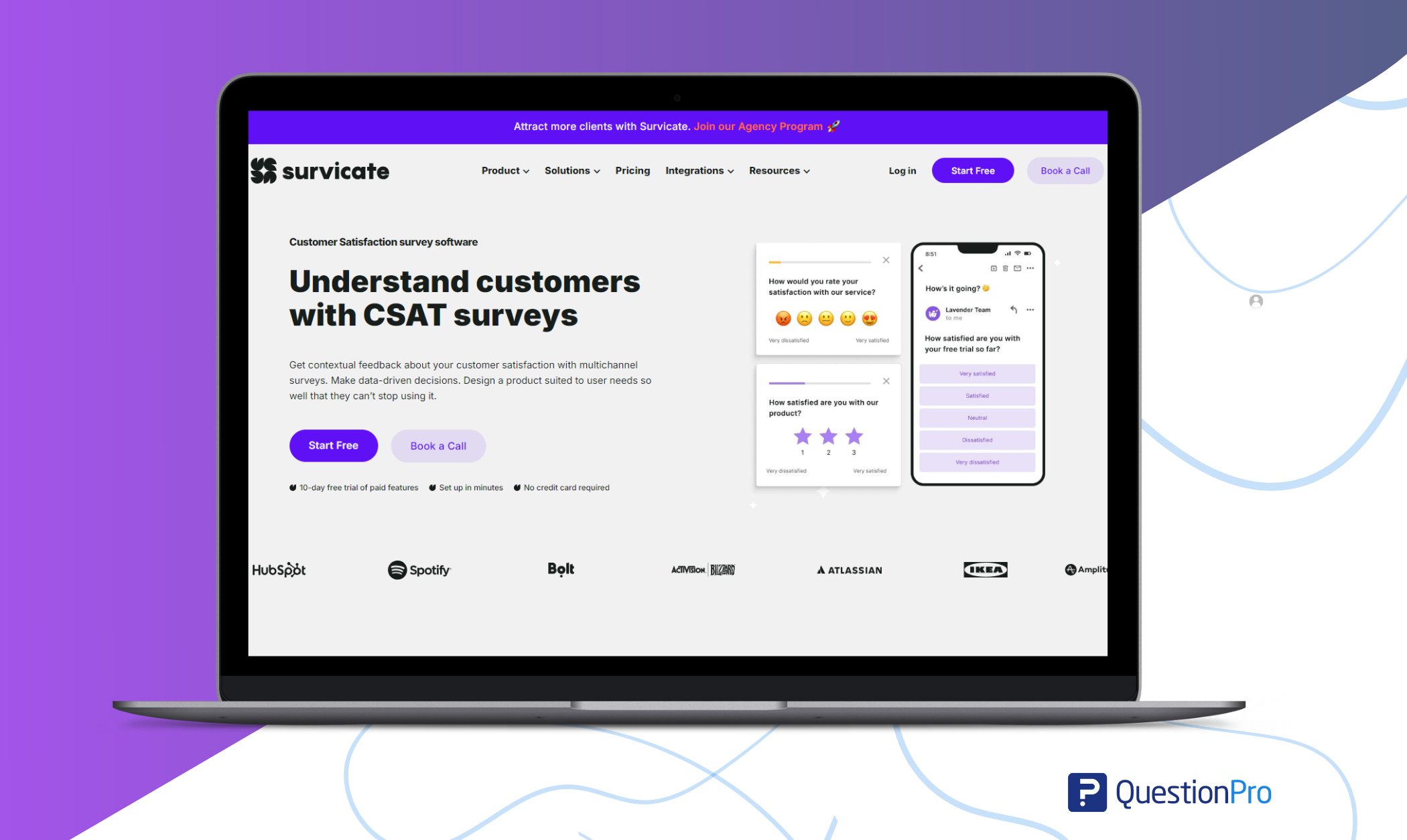
Features:
- Versatile survey creation and deployment options
- Real-time survey analytics and reporting
- NPS measurement and tracking features
- Website feedback widgets for capturing insights
- Customizable survey templates for various use cases
- Integration with CRM and other systems
Limitations:
- Limited integrations with other platforms compared to more established survey tools
- Some users report occasional glitches or technical issues with the platform
- Advanced features may require higher-tier pricing plans
Pricing:
Offers tiered pricing based on features and usage, with customized plans for larger organizations.
8. Freshdesk
Freshdesk is a well-known customer support software that allows businesses to streamline customer service operations. Its ticketing, self-service, and automation features help organizations improve efficiency, reduce resolution times, and deliver seamless customer support experiences across multiple channels.
Features:
- Ticketing system for managing customer inquiries
- Multichannel support for email, chat, phone, and social media
- Knowledge management software for self-service options
- Workflow automation for efficient issue resolution
- Analytics dashboard for tracking customer support metrics
- Integration with CRM and other business systems
Limitations:
- Some users report occasional delays or issues with customer support response times
- Integration with other platforms can sometimes be complex
- Advanced features may require additional costs or higher-tier pricing plans
- Customization options for support ticketing workflows may be limited
Pricing:
Freshdesk has both a free trial and a free plan. The pro plan costs 49 euros per month with a yearly payment.
9. Medallia
Medallia is an enterprise-grade experience management platform that helps businesses capture, analyze, and act on real-time customer data feedback. Leveraging AI-powered insights, predictive analytics, and omnichannel engagement capabilities, Medallia enables organizations to deliver personalized and seamless experiences, driving customer satisfaction and loyalty.
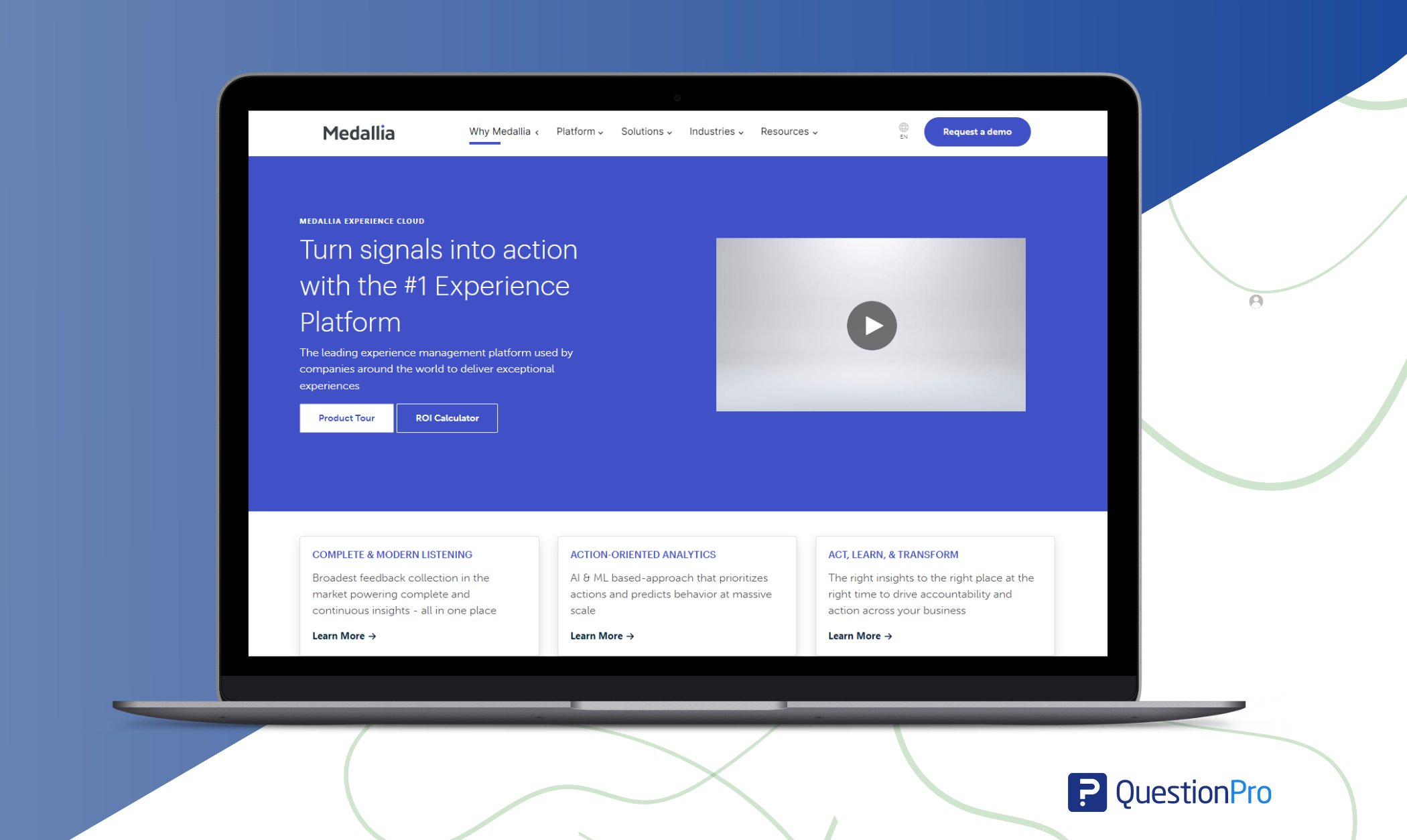
Features:
- Voice of the customer (VoC) programs for feedback collection
- AI-powered analytics for actionable insights
- Journey mapping tools for visualizing customer experiences
- Predictive analytics for anticipating customer needs
- Multichannel feedback collection capabilities
- Integration with CRM and other business systems
Limitations:
- High cost of entry, making it less accessible for smaller businesses
- The complexity of the platform may require dedicated training and resources
- The implementation process may be lengthy and resource-intensive
- Some users report challenges in customizing the platform to their specific needs
Pricing:
Pricing is available upon request and typically tailored based on the size and requirements of each organization.
10. Oracle
Oracle offers a range of customer experience solutions, including CRM, marketing automation, and service cloud platforms. Its comprehensive features, including lead management, pipeline tracking, and customer engagement tools, enable businesses to deliver personalized experiences and manage customer interactions across channels.
Features:
- Comprehensive CRM for managing customer experience relationships
- Marketing automation tools for personalized messaging
- Service cloud platform for customer support
- Predictive analytics for identifying customer trends
- Integration with ERP and other business systems
- Customizable customer experience solutions
Limitations:
- High cost of entry, especially for smaller businesses
- The complexity of the platform may require extensive training and resources
- The implementation process may be lengthy and resource-intensive
- Limited customization options compared to more flexible platforms
Pricing:
Pricing varies depending on the specific applications and services required, with custom pricing available upon request.
11. SurveySparrow
SurveySparrow is a user-friendly survey software that helps businesses create engaging surveys to collect customer feedback. Its conversational survey design, NPS measurement, and mobile-friendly interface, SurveySparrow, make it easy for organizations to gather actionable insights and improve the overall customer experience.
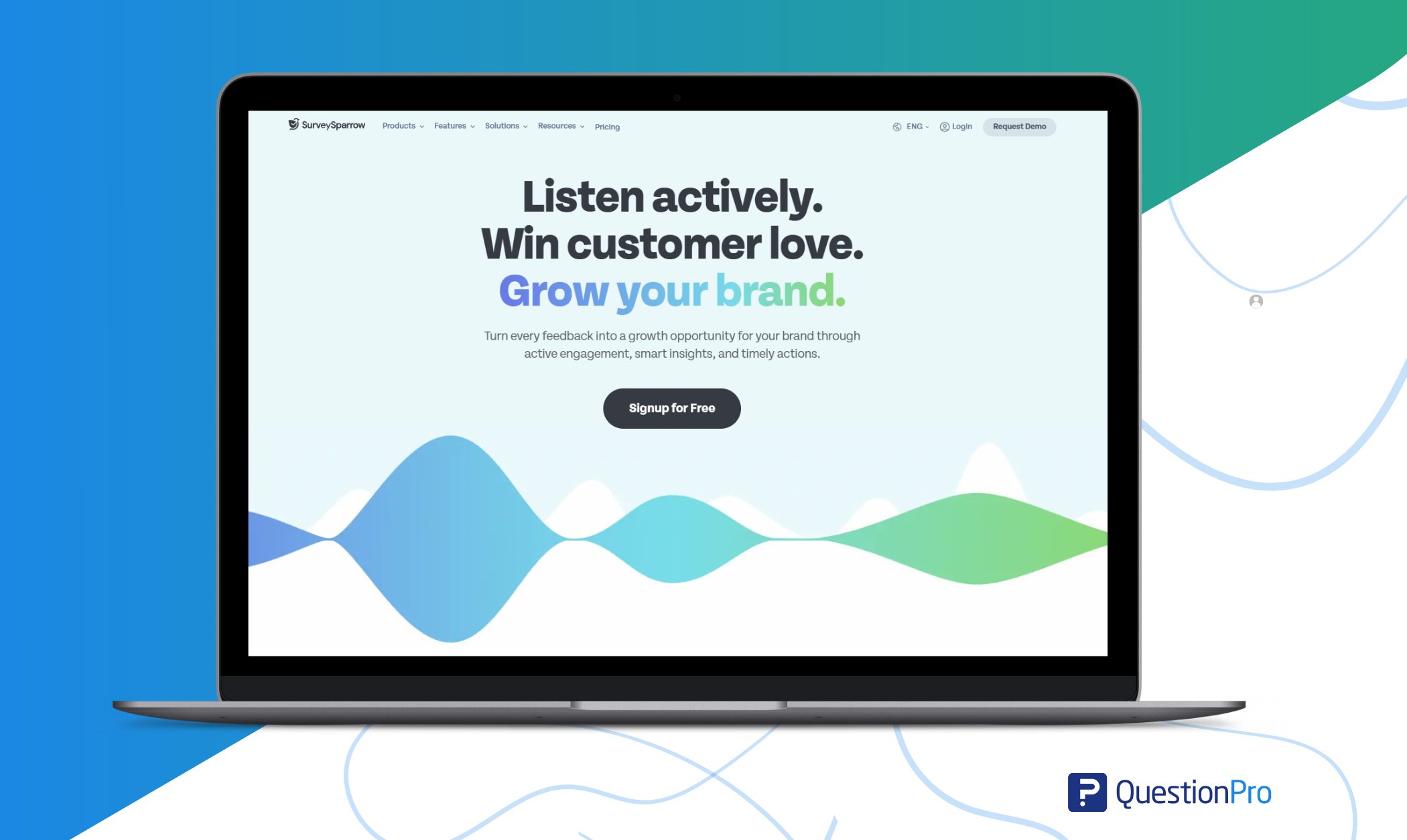
Features:
- Conversational survey design for engaging experiences
- Mobile-friendly survey templates
- Real-time survey analytics and reporting
- NPS measurement and tracking features
- Personalized survey experiences based on customer data
- Integration with CRM and other customer experience tools for seamless data syncing
Limitations:
- Limited customization options for survey design compared to other platforms
- Advanced features may be lacking in lower-tier pricing plans
- Integration capabilities may not be as robust as other survey tools
- Some users report occasional issues with survey performance and reliability
Pricing:
SurveySparrow presents a free plan with limited features, and paid plans, which include more advanced survey features and customization options, start at around $39 per month.
12. Sprinklr
Sprinklr is a top social media management platform that helps businesses manage and analyze social media interactions. Its social listening, publishing, and analytics features empower organizations to monitor brand mentions, engage with customers, and enhance their brand reputation and customer experience.
Features:
- Social media management tools for monitoring and engaging with customers
- Social listening tool capabilities for tracking brand mentions and customer sentiment
- Publishing platform for scheduling and publishing social media content
- Analytics dashboard for monitoring social media performance metrics
- Integration with CRM and other business systems
- Customizable customer engagement solutions
Limitations:
- The high cost of entry may be prohibitive for smaller businesses
- The complexity of the platform may require extensive training and resources
- Integration with other systems can sometimes be challenging
- Some users report challenges in customizing Sprinklr to their specific needs
Pricing:
The Advance plan starts at $249, and there is also an Enterprise plan. Get a quote customized to your requirements.
13. Zendesk
Zendesk is a top customer service and engagement platform that enables businesses to provide support across multiple channels, including email, chat, social media, and phone. Its comprehensive features, including ticketing, self-service, and analytics tools, help organizations deliver fast, personalized, and efficient customer support experiences.
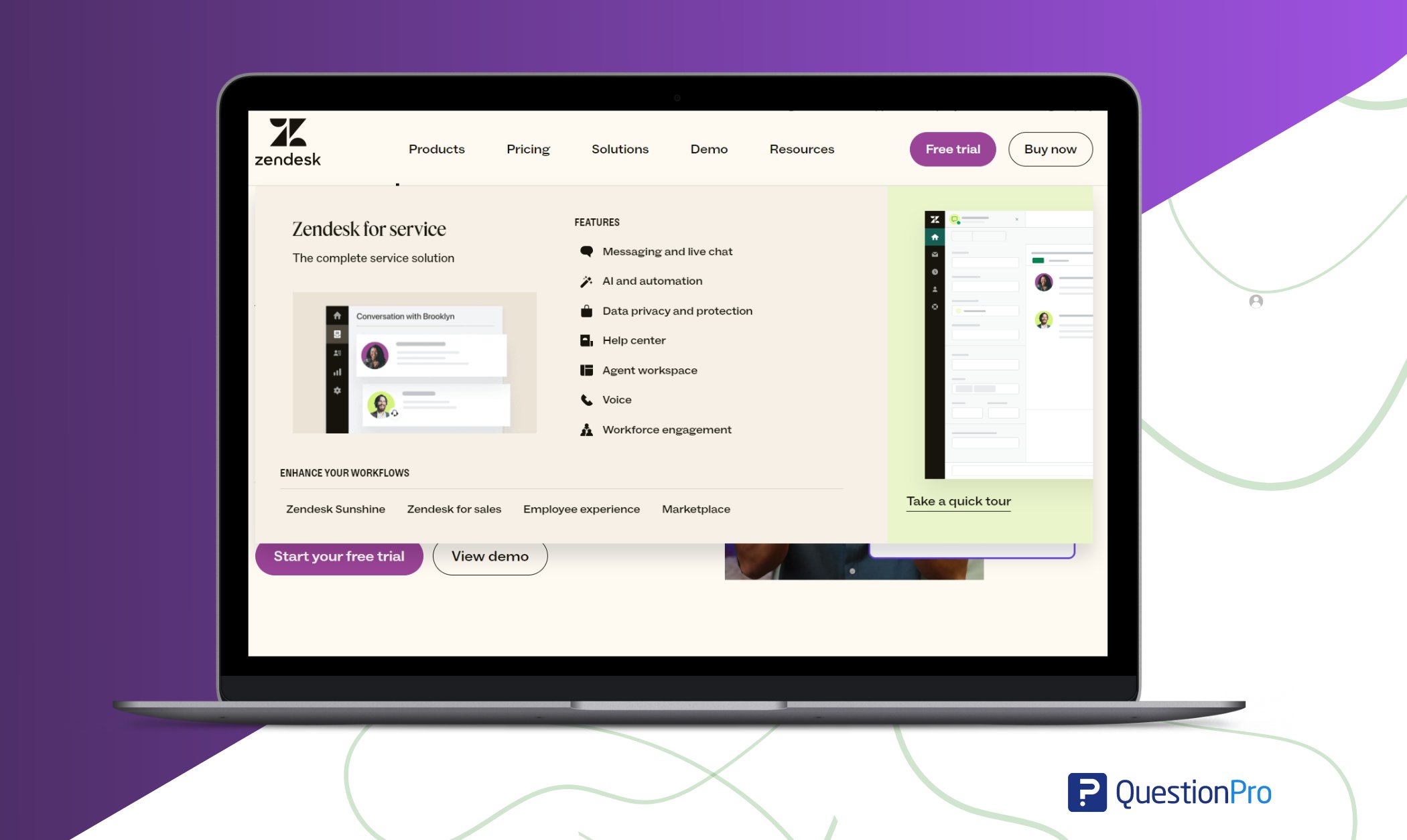
Features:
- Ticketing system for managing customer inquiries
- Multichannel support for email, chat, phone, and social media
- Knowledge base management for self-service options
- Workflow automation for efficient issue resolution
- Analytics dashboard for tracking customer support metrics
- Integration with CRM and other business systems
Limitations:
- Pricing plans may not be suitable for smaller businesses or startups
- Integration with other platforms can sometimes be complex
- Advanced features may require additional training to be utilized fully
- Customization options for support ticketing workflows may be limited
Pricing:
Pricing starts at around $5-$19 per user per month for the Support Suite, with additional costs for other features like Chat, Talk, and Explore. Custom pricing is available for larger enterprises.
14. UserZoom
UserZoom is a user experience research platform that helps businesses understand and optimize digital experiences. Its usability testing, surveys, and behavioral analytics features enable organizations to identify customer pain points, gather actionable insights, and improve the overall customer experience.
Features:
- User experience research platform for understanding customer behavior
- Usability testing tools for evaluating digital experiences
- Surveys and feedback collection features for gathering customer insights
- Behavioral analytics for tracking user interactions
- Integration with CRM and other business systems
- Personalized customer experience solutions
Limitations:
- High cost of entry, making it less accessible for smaller businesses
- The complexity of the platform may require dedicated training and resources
- Some users report challenges in integrating UserZoom with other systems
- Limited customization options compared to more flexible user experience research platforms
Pricing:
UserZoom provides pricing based on each business’s specific needs and scale. They typically offer customized pricing plans tailored to factors such as the number of users, projects, and features required.
15. InMoment
InMoment is a customer experience software that helps businesses understand and improve the customer experience. Its voice of the customer (VoC) programs, employee engagement solutions, and predictive analytics capabilities empower organizations to drive meaningful improvements and deliver exceptional experiences across all touchpoints.
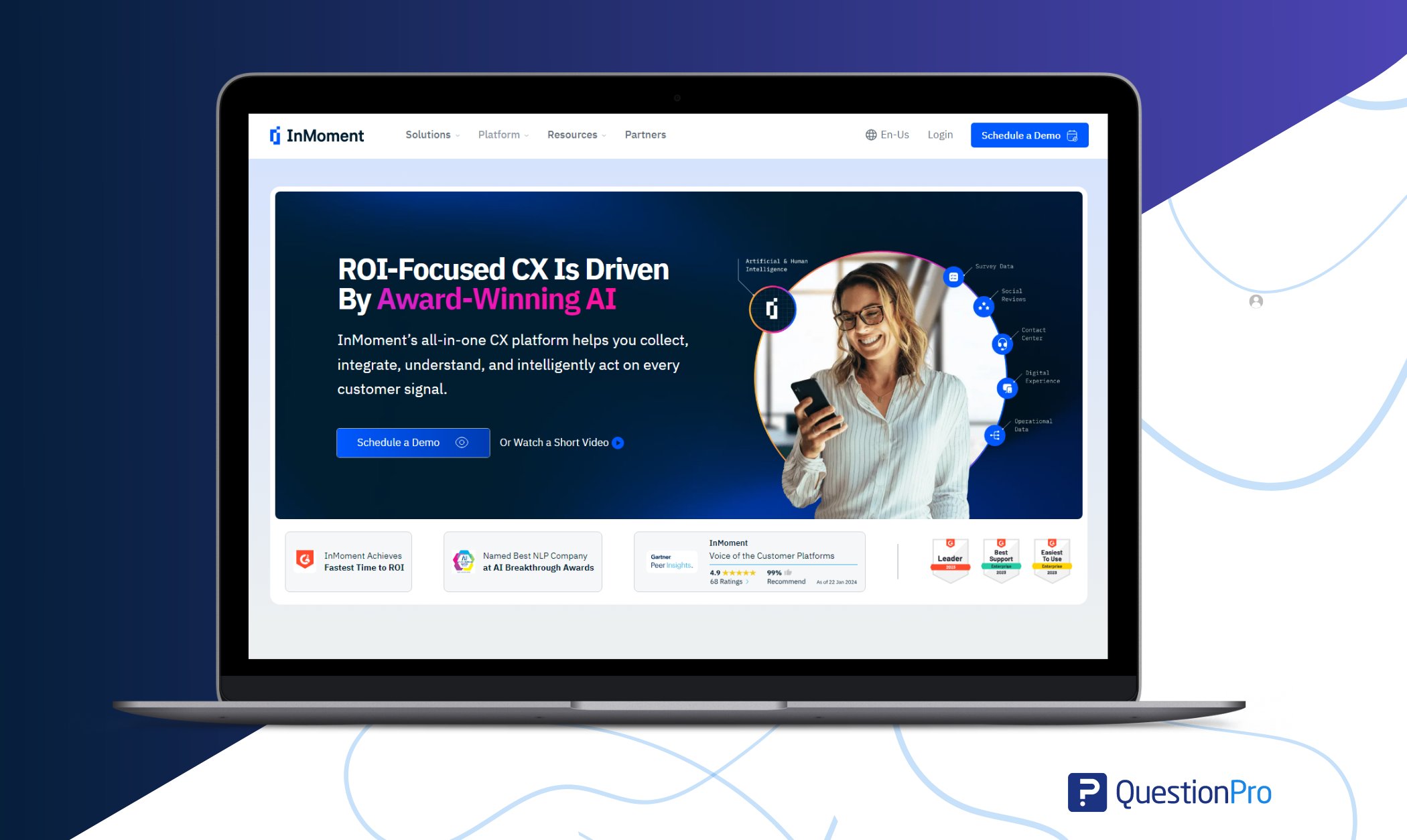
Features:
- Voice of the customer (VoC) programs for feedback collection
- Employee engagement surveys and analytics
- Predictive analytics for identifying customer trends
- Journey mapping tools for visualizing customer experiences
- Integration with CRM and other business systems
- Personalized customer experience solutions
Limitations:
- The high cost of entry may be prohibitive for smaller businesses
- The complexity of the platform may require dedicated training and resources
- Some users report challenges in integrating InMoment with other systems
- All users may not fully utilize advanced features
Pricing:
Provides various pricing plans based on data volume and features, with custom pricing for enterprise feedback solutions.
16. Reputation
Reputation is a powerful reputation management and customer experience platform that helps businesses monitor and manage online reviews, surveys, and customer feedback. With its review generation, sentiment analysis, and competitive benchmarking features, reputation enables organizations to enhance their online reputation and customer experience effectively.
Features:
- Online review monitoring and customer experience management tools
- Sentiment analysis for understanding customer feedback
- Review generation features to encourage positive reviews
- Competitive benchmarking insights
- Local business listings management
- Integration with popular review platforms
Limitations:
- Some users report challenges in managing and responding to reviews at scale
- Integration capabilities may be limited compared to some other reputation management platforms
- Advanced analytics and reporting features may require higher-tier pricing plans
Pricing:
Pricing starts from $100 per month for basic features, with custom plans available for larger businesses.
17. Zoho Desk
Zoho Desk is a popular customer support platform and knowledge management system that helps businesses deliver exceptional customer service. Its ticketing, knowledge base management, and multichannel support features enable organizations to streamline support operations, enhance response times, and enhance the customer experience.
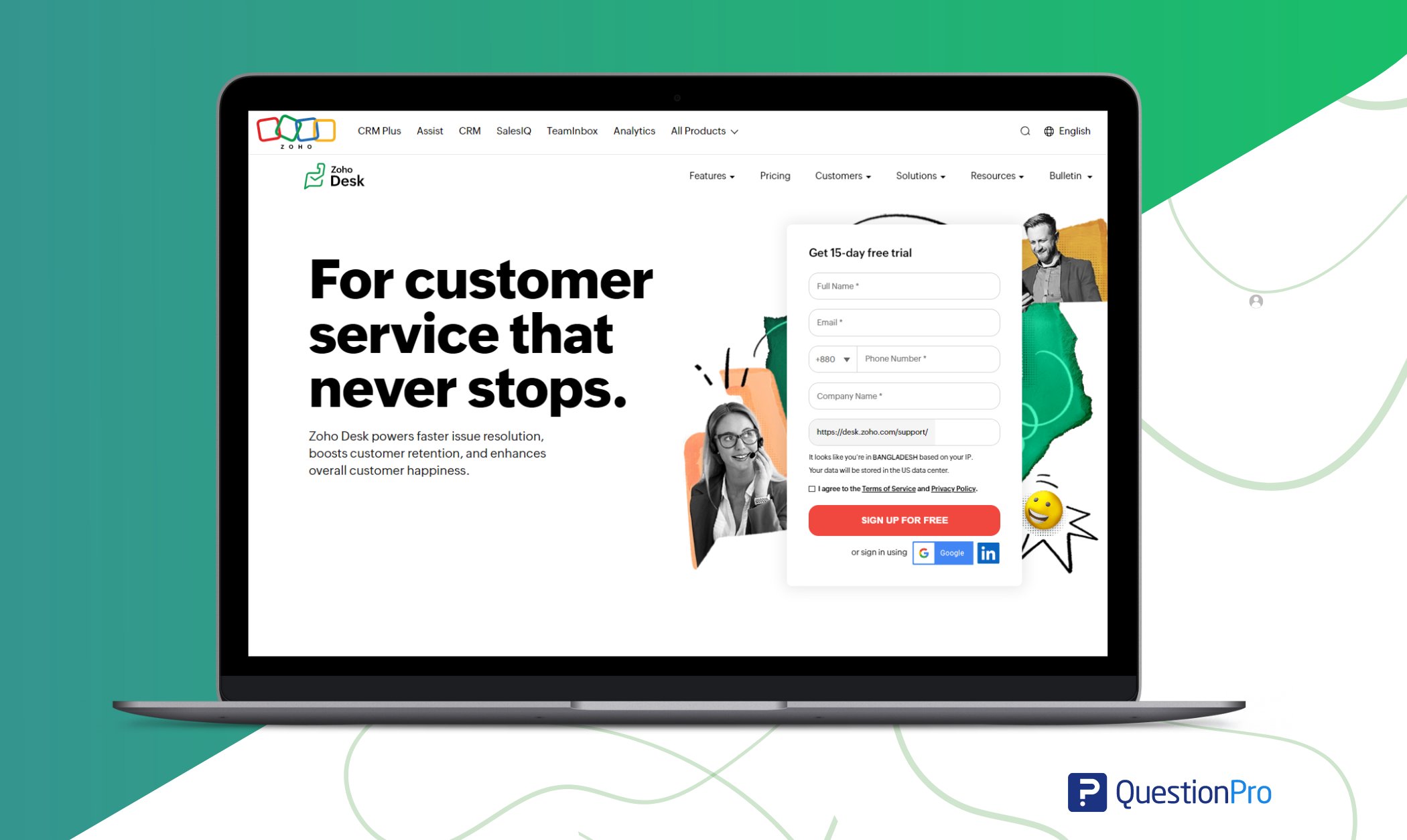
Features:
- Help desk software for managing customer inquiries
- Ticketing system with automated workflows
- Knowledge base management for self-service options
- Multichannel support for email, chat, phone, and social media
- Analytics dashboard for tracking customer support metrics
- Integration with CRM and other business systems
Limitations:
- Some users report limitations in customization options for support ticketing workflows
- Integration capabilities may not be as robust as other customer service platforms
- Advanced features may require additional costs or higher-tier pricing plans
Pricing:
Pricing starts at around $14 per user per month for the Basic plan, with higher-tier plans available for advanced features and larger teams.
18. Hiver
Hiver is a customer service platform that enables businesses to collaborate on email responses and manage shared inboxes. Its features for email delegation, assignment, and tracking help organizations streamline email communication, improve response times, and deliver exceptional customer support experiences.
Features:
- Shared inbox management for collaborative email responses
- Email delegation and assignment features
- Automated email workflows for efficient issue resolution
- Analytics dashboard for tracking email performance metrics
- Integration with CRM and other business systems
- Collaboration tools for team communication and coordination
Limitations:
- Some users report limitations in customization options for email workflows and templates
- Integration capabilities may not be as robust as other help desk platforms
- Advanced features may require additional costs or higher-tier pricing plans
Pricing:
The paid plan starts at $15. It also has a pro plan($49) and an elite plan($79).
19. Salesforce CRM
Salesforce CRM is a premier customer relationship management platform that helps industries manage sales, marketing, and customer service operations. Its lead management, pipeline tracking, and customer engagement features enable organizations to build strong customer relationships and deliver personalized experiences at scale.
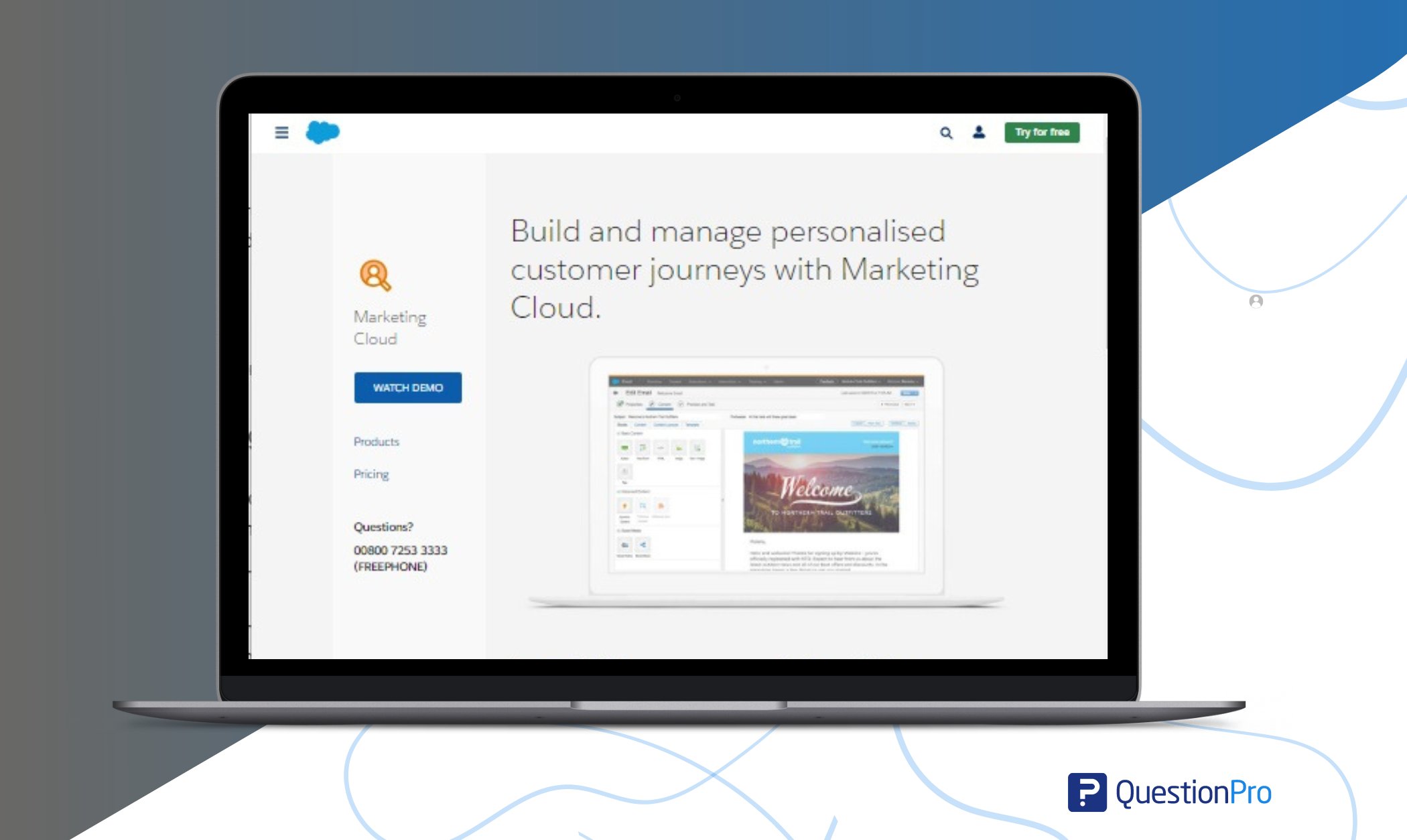
Features:
- Comprehensive CRM for managing customer relationships
- Marketing automation tools for personalized messaging
- Service cloud platform for customer support
- Predictive analytics for identifying customer trends
- Integration with ERP and other business systems
- Customizable customer experience management solutions
Limitations:
- High cost of entry, especially for businesses with limited budgets
- The complexity of the platform may require extensive training and resources
- Integration with other systems can sometimes be challenging
- Some users report limitations in customization options for specific use cases
Pricing:
Offers custom pricing based on each organization’s specific needs and scale. Pricing is available upon request.
20. Satmetrix
It is a customer experience management platform that helps businesses measure and improve customer loyalty. Its features for Net Promoter Score (NPS) programs, customer journey mapping, and predictive analytics empower organizations to drive meaningful improvements and foster long-term customer relationships.
Features:
- NPS (Net Promoter Score) tracking and analysis
- Voice of the Customer (VoC) programs for feedback collection
- Predictive analytics for trend forecasting
- Real-time alerts for immediate issue resolution
- Integration with CRM and other enterprise systems
- Reporting and analytics for tracking customer lifecycle
Limitation:
- Limited integration capabilities compared to more robust customer experience management platforms
- Pricing plans may not be suitable for smaller businesses or startups
- The implementation process may be lengthy and resource-intensive
Pricing:
Customized pricing plans based on factors such as the number of users, features required, and level of support.
21. LiveAgent
LiveAgent is a service desk and live chat software that enables customer support teams or customer service teams to provide real-time customer support. Its ticketing, chat routing, and knowledge base management features help organizations deliver fast, personalized, and efficient customer support experiences across multiple channels.
Features:
- Help desk software for managing customer queries
- Live chat support for real-time customer interactions
- Ticketing system with automated workflows
- Knowledge base management for self-service options
- Multichannel support for email, chat, phone, and social media
- Integration with CRM and other business systems
Limitations:
- Some users report occasional delays or issues with customer support response times
- Integration with other platforms can sometimes be complex
- Advanced features may require additional costs or higher-tier pricing plans
Pricing:
Pricing starts at around $9 per user per month for the Basic plan.
These CEM software solutions play a crucial role in helping businesses understand and enhance customer experience management systems. Investing in the right CEM software can lead to long-term customer success and sustainable growth by prioritizing and optimizing every customer interaction.
You can also learn about Idea Management Software published by QuestionPro!
Comparison Table for Best Customer Experience Management Software
Here is a quick side-by-side look at the first 10 CEM tools from your list so readers can compare strengths, ratings, and pricing at a glance.
| Tools | Key Features | G2 Rating | Pricing |
| QuestionPro CX | Multichannel feedback collection, real-time CX analytics, predictive customer analytics, strong survey customization, CRM integrations | 4.5 | Start at $99/month |
| Jotform | Online form and survey builder, rich template library, real-time form analytics, CRM and app integrations, mobile-friendly forms, secure data storage | 4.7 | Start at $34/month |
| Qualtrics | Advanced survey logic, omnichannel feedback, strong analytics and dashboards, AI-based predictive insights, CX journey programs, wide enterprise integrations | 4.3 | Start at $1500/yearly |
| Podium | Review management, central inbox for messages, SMS and webchat, feedback requests, reputation analytics, integrations with major review sites | 4.6 | Pricing is available upon request |
| HubSpot | Unified CRM, ticketing and help desk, marketing automation, omnichannel support, workflows, customer health and engagement analytics | 4.5 | Start at $50/month |
| Birdeye | Online review monitoring, review generation, messaging, sentiment analysis, competitive benchmarking, social and listing management | 4.7 | Pricing is available upon request |
| Survicate | Website, in-app and email surveys, NPS tracking, feedback widgets, real-time analytics, templates, CRM and marketing integrations | 4.6 | Pricing is available upon request |
| Freshdesk | Ticketing help desk, multichannel support (email, chat, phone, social), knowledge base, automations, reporting and dashboards, marketplace apps | 4.4 | Pricing is available upon request |
| Medallia Customer Experience | Enterprise VoC programs, omnichannel feedback capture, AI-driven analytics, journey mapping, predictive insights, deep enterprise integrations | 4.5 | Pricing is available upon request |
| Oracle CX | Enterprise CRM and CX suite, service cloud for support, marketing and sales tools, strong analytics, tight ERP integration, scalable architecture | 3.9 | Pricing is available upon request |
Why QuestionPro Can be The Best Choice
QuestionPro stands out as one of the best Customer Experience Management (CEM) software solutions for several reasons:
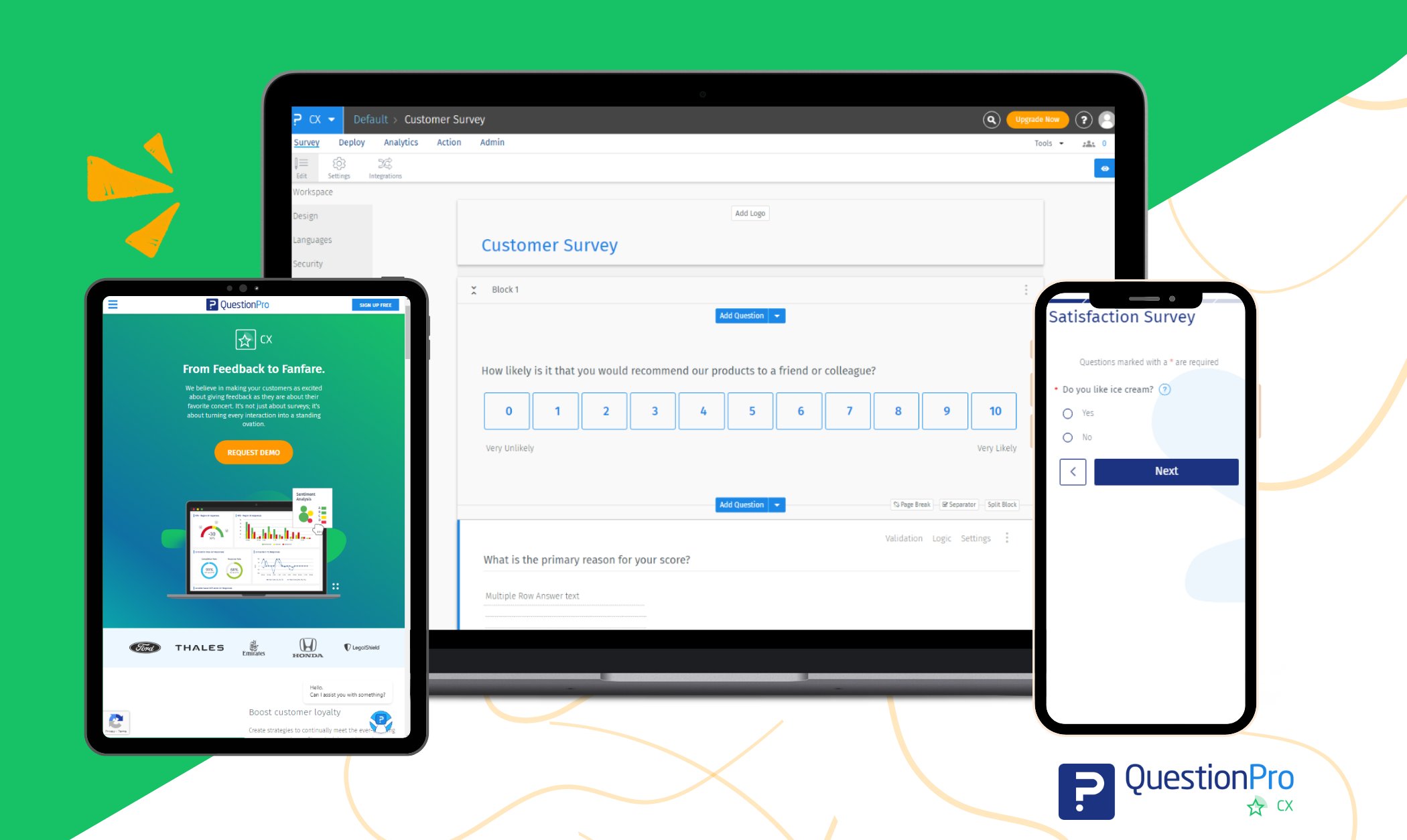
1. Comprehensive Feedback Management
QuestionPro offers a robust suite of tools for collecting feedback through surveys, polls, and online forms. This comprehensive feedback management capability allows businesses to gather insights at every customer journey touchpoint.
2. Real-time Analytics and Reporting
With advanced analytics features of QuestionPro:
- Allow businesses to analyze customer feedback and generate actionable insights.
- Customizable dashboards and reporting tools simplify tracking key performance indicators (KPIs) related to customer satisfaction.
- Identify areas for improvement with ease through comprehensive analysis.
3. Omnichannel Support
QuestionPro supports omnichannel feedback collection, allowing businesses to gather insights from various sources, including email, websites, social media, and mobile apps. It ensures that organizations can track customer feedback wherever they are, leading to a more holistic view of the customer experience.
4. Personalization and Segmentation
QuestionPro’s personalization features enable businesses to tailor surveys and customer conversations based on customer preferences, demographics, and behaviors. This level of customization helps organizations deliver more relevant and engaging experiences to their customers, ultimately driving satisfaction and loyalty.
5. Predictive Analytics
QuestionPro helps businesses anticipate customer needs and behaviors by leveraging predictive analytics algorithms. This proactive approach allows organizations to identify trends, forecast outcomes, and take preemptive actions to enhance the customer experience.
6. Integration Capabilities
QuestionPro integrates seamlessly with other systems and tools. Integration includes:
- CRM platforms.
- Marketing automation software.
- Customer support solutions.
This integration ensures a unified view of customer data and interactions, enabling businesses to deliver cohesive and personalized experiences across all customer touchpoints.
QuestionPro stands out as a top choice for businesses seeking a user-friendly CEM solution that enables them to collect, analyze, and act on customer feedback effectively. With its advanced features, QuestionPro can help companies elevate their customer experience management efforts and drive long-term success.
How to Implement The CEM Software
Implementing Customer Experience Management (CEM) software involves several vital steps to ensure successful adoption and utilization across the organization. Here’s a guide on how to implement CEM software effectively:
1. Define Objectives and Goals:
Define your objectives and goals for implementing CEM software. Determine what you aim to achieve, whether improving customer satisfaction, increasing retention rates, or enhancing brand loyalty.
2. Conduct a Needs Assessment:
Assess your organization’s current state of customer experience management. Identify pain points, areas for improvement, and gaps in existing processes that CEM software can address.
3. Research and Select the Right Software:
Research available CEM software solutions that align with your objectives and needs, considering:
- Features.
- Scalability.
- Ease of use.
- Integration capabilities.
- Pricing.
- Comprehensive support and training resources.
4. Engage Stakeholders:
Involve key stakeholders from various departments, including customer service, marketing, sales, and IT, in the decision-making process. Gain their buy-in and support for the implementation of CEM software.
5. Customize the Software:
Collaborate closely with the customer experience management platform to tailor and set up the system according to your unique needs. This involves:
- Collaborate closely with the customer experience management platform to tailor and set up the system according to your unique needs. This involves:
- Defining workflows.
- Establishing automation rules.
- Integrate with other solutions, such as CRM platforms and marketing tools.
6. Provide Training and Education:
Ensure that employees are adequately trained to use the CEM software effectively. Offer training sessions, workshops, and resources to familiarize customers with the software’s features and functionalities.
7. Implement Pilot Programs:
Pilot the CEM software with a small group of users or within a specific department before rolling it out organization-wide. Gather feedback, identify issues or challenges, and make necessary adjustments before full implementation.
8. Communicate and Promote Adoption:
Communicate the benefits of the CEM software to employees across the organization. Highlight how it will improve their workflows, enhance customer relationship management, and contribute to business success. Encourage active participation and adoption.
9. Monitor and Measure Performance:
Select key performance indicators (KPIs) to follow the effectiveness of the CEM software implementation:
- Customer Satisfaction Scores: Monitor overall customer happiness and areas for improvement.
- Retention Rates: Track to understand customer loyalty and identify factors influencing customer retention.
- Feedback Response Times: Measure to ensure timely responses to customer feedback and maintain customer engagement.
Use customer data insights to make informed decisions and adjustments as needed.
10. Continuous Improvement:
Continuously evaluate and optimize your use of the CEM software over time. Solicit user feedback, review performance metrics, and implement updates or new features provided by the software provider. Embrace a culture of continuous progress to maximize the value of your CEM software investment.
By following these steps, organizations can effectively implement CEM software to enhance the customer experience, drive business outcomes, and stay competitive in today’s market.
Conclusion
Customer experience management software is pivotal for businesses striving to excel in today’s customer-centric market. This CX software empowers organizations to comprehend, analyze, and optimize every facet of the customer journey through its comprehensive features, which encompass feedback management, real-time analytics, omnichannel support, personalization, and predictive analytics.
Through proactive issue resolution, optimized customer journeys, and data-driven decision-making, businesses can increase customer satisfaction, foster loyalty, and gain a competitive edge. Moreover, the seamless integration capabilities and scalability of CEM software make it accessible and adaptable for businesses of all sizes and industries.
CEM software enables businesses to prioritize customer experience, align departments, and drive continuous improvement, leading to increased revenue, efficiency, and long-term success. As organizations prioritize customer loyalty and satisfaction, investing in robust CEM software becomes essential for staying ahead in today’s dynamic business landscape.
Customer experience management software refers to technology solutions used to help businesses manage and improve the interactions and experiences they provide to their customers across various touchpoints and channels.
No, customer experience (CX) is not the same as CRM.
CX: The overall impression from all customer interactions.
CRM: Tools and strategies for managing customer data and relationships.
Customer Experience Management (CEM) software plays a crucial role in today’s business landscape due to several key reasons:
1. Enhanced Customer Satisfaction
2. Improved Customer Retention
3. Competitive Advantage
4. Data-Driven Insights
5. Optimized Customer Journeys
6. Efficiency and Cost Savings




